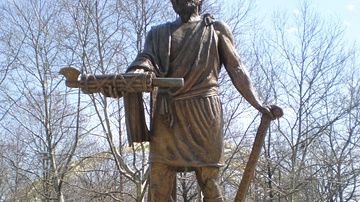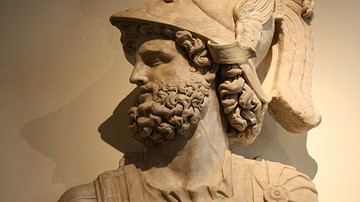Search
Remove Ads
Advertisement
Search Results

Video
Campus Martius - Ancient Rome Live (AIRC)
The Campus Martius is the massive flood plain defined by the massive curve of the Tiber River that stretches from above Piazza del Popolo to beyond the Tiber Island, roughly over a square mile. This flood plain was a place of exercise and...

Article
Athletics, Leisure, and Entertainment in Ancient Rome
Although much of ancient Roman life revolved around negotium (work and business), there was also time available for otium (leisure). Ranging from swimming to playing board games to attending theatre performances, athletics and forms of entertainment...

Definition
Cincinnatus
Lucius Quinctius Cincinnatus was a Roman consul (460 BCE) and dictator (458 and 439 BCE), a legendary figure in the early days of the Roman Republic. He responded to a call from the city fathers, left his plow lying in the fields, donned...

Article
Chariot Racing in Ancient Rome
Chariot racing was very big business in ancient Rome. There was a whole industry built around the factions, the four professional stables known by their team colour – Blue, Green, Red, and White –, providing all that was required for a race...

Definition
Mars
Mars was the Roman god of war and second only to Jupiter in the Roman pantheon. Although most of the myths involving Mars were borrowed from the Greek god of war Ares, Mars did have some uniquely Roman features. Mars is considered more level-headed...

Video
Portico of Octavia - Ancient Rome Live
The Portico of Octavia in the Circus Flaminius, part of the southern Campus Martius, was the monumental entrance to a complex with two temples - Jupiter and Juno- surrounded by porticoes. The first on the spot was 2nd Century BCE, built...

Image
Circus of Maxentius, Spina
The Circus of Maxentius is the best-preserved Roman circus in Rome and is second only in size to the Circus Maximus. It lies outside the city, between the second and third milestones along the Appian Way (Via Appia). This circus was part...

Image
Sphinx of Amasis
A basanite statue of a sphinx with the features of pharaoh Amasis. 26th Dynasty, 568-526 BCE. From the Temple of Isis in the Campus Martius, Rome. (Capitoline Museums, Rome)

Article
Top 5 Must-See Historical Sites in Dublin
Dublin has much to offer in cultural and historical experiences. It is a vibrant and colorful city, with a history dating back many centuries. Dublin has it all - from castles and a Viking harbor to ancient pubs, medieval libraries, and more...

Video
Roman Theaters - Ancient Rome Live (AIRC)
Theaters in Rome were constructed temporarily in the Republican era for annual festivals, notably for Magna Mater on the Palatine and Apollo in the Campus Martius. The structures were made of wood and set up fo the performances, then dismantled...